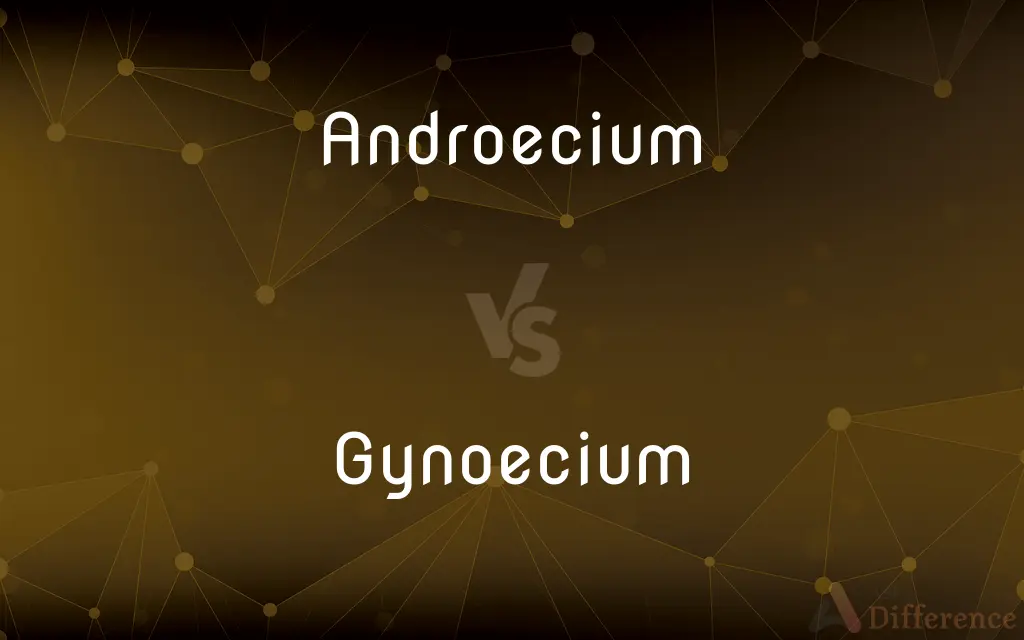Androecium vs. Gynoecium — What's the Difference?
By Tayyaba Rehman — Updated on November 2, 2023
Androecium is the male reproductive part of a flower, comprising stamens. Gynoecium is the female part, made up of one or more carpels.

Difference Between Androecium and Gynoecium
Table of Contents
ADVERTISEMENT
Key Differences
The Androecium and Gynoecium are fundamental components of a flowering plant's reproductive system. Androecium consists of stamens, each comprising an anther and a filament, responsible for producing and releasing pollen. In contrast, the Gynoecium is composed of carpels, each including an ovary, style, and stigma, which are responsible for producing ovules and later, when fertilized, seeds.
Within the Androecium, stamens can vary in number and arrangement, influencing a flower's reproductive strategies. The Gynoecium can be simple, with a single carpel, or compound, with multiple fused carpels. These structures are essential for sexual reproduction, as the Androecium's pollen must reach the Gynoecium's stigma for fertilization to occur.
Pollination mechanisms are designed to facilitate the transfer of pollen from the Androecium to the stigma of the Gynoecium. This can occur within the same flower, between flowers on the same plant, or between flowers on different plants. The Androecium and Gynoecium have evolved various adaptations to optimize this process.
In some species, the Androecium and Gynoecium mature at different times to prevent self-fertilization, a concept known as dichogamy. Moreover, the Androecium and Gynoecium often exhibit distinctive colors, shapes, and scents to attract pollinators, which are vital for the plant's reproductive success.
The study of the Androecium and Gynoecium is crucial for understanding plant breeding, genetics, and horticulture. While the Androecium's pollen contributes to genetic diversity, the Gynoecium's structure determines fruit and seed development, influencing agricultural practices and crop yields.
ADVERTISEMENT
Comparison Chart
Part of Flower
Male reproductive parts: stamens.
Female reproductive parts: carpels.
Components
Consists of anthers and filaments.
Made up of ovaries, styles, and stigmas.
Function
Produces pollen for fertilization.
Produces ovules; receives pollen.
Structure
Can be free or fused stamens.
Single (simple) or multiple (compound) carpels.
Variability
Often varies in number and arrangement.
Varies in number; may be fused or separate.
Compare with Definitions
Androecium
Androecium refers to the collective male reproductive organs in a flower.
The androecium of the lily is prominently displayed, attracting bees.
Gynoecium
The gynoecium consists of all the carpels in the flower.
She pointed out that the gynoecium’s ovaries contained multiple ovules.
Androecium
The androecium is the sum of a flower's stamens.
A botanist examined the androecium to assess the flower's pollen viability.
Gynoecium
Gynoecium includes the structures that receive pollen and house ovules.
The gynoecium of this species develops into a fruit after fertilization.
Androecium
Androecium includes the pollen-bearing structure in the flower.
The flower's androecium was rich with pollen, ready for the pollinators.
Gynoecium
Gynoecium is the collective female reproductive parts within a flower.
The gynoecium is central in the flower, signaling its readiness for pollination.
Androecium
Androecium encompasses all the male parts of the flower that produce pollen.
During dissection, the student carefully separated the androecium from the rest of the flower.
Gynoecium
Gynoecium refers to the female reproductive apparatus in the flower.
Insect pollinators are attracted to the gynoecium for its nectar, aiding in pollination.
Androecium
The term androecium denotes the aggregate of stamens in the flower's structure.
He noted that the androecium's anthers were dehiscent, releasing pollen into the air.
Gynoecium
The term gynoecium represents the pistil or pistils of the flowering plant.
The garden's showcase plant had a complex gynoecium that intrigued the botanists.
Androecium
The stamens of a flower considered as a group.
Gynoecium
Gynoecium (, from Ancient Greek γυνή (gyne, "woman") and οἶκος (oikos, "house")) is most commonly used as a collective term for the parts of a flower that produce ovules and ultimately develop into the fruit and seeds. The gynoecium is the innermost whorl of a flower; it consists of (one or more) pistils and is typically surrounded by the pollen-producing reproductive organs, the stamens, collectively called the androecium.
Androecium
(botany) The set of a flower's stamens.
Gynoecium
The female reproductive organs of a flower; the pistil or pistils considered as a group.
Androecium
The stamens of a flower taken collectively.
Gynoecium
(botany) The pistils of a flower considered as a group
Androecium
A male gametoecium
Gynoecium
The pistils of a flower, taken collectively. See Illust. of Carpophore.
Gynoecium
A female gametoecium
Common Curiosities
Are androecium and gynoecium present in all flowers?
Most flowers have both androecium and gynoecium, but some may have only one (unisexual) or may lack both (asexual).
Can the androecium and gynoecium vary in form?
Yes, both can vary significantly in form and structure between different plant species.
What is the androecium?
The androecium is the collective term for the stamens, the male reproductive parts of a flower.
Can plants have multiple androecia or gynoecia?
Plants can have multiple stamens and carpels, but they collectively form the androecium and gynoecium, respectively.
What does the gynoecium consist of?
The gynoecium consists of the flower's carpels, which include the ovary, style, and stigma.
How do the androecium and gynoecium contribute to reproduction?
The androecium produces pollen, while the gynoecium receives pollen and facilitates the development of seeds.
Are the androecium and gynoecium always distinct?
In some flowers, the androecium and gynoecium are distinct, while in others they may be fused or share common structures.
What is the plural of androecium and gynoecium?
The plurals are androecia and gynoecia.
What is the difference between a monoecious and dioecious plant in terms of these structures?
Monoecious plants have both androecium and gynoecium on the same plant, while dioecious plants have them on separate plants.
Is the androecium involved in attracting pollinators?
Yes, the androecium can attract pollinators through its anthers and the pollen they produce.
How are androecium and gynoecium affected by environmental factors?
Environmental factors can influence their development, maturation, and function in plant reproductive strategies.
Does the gynoecium play a role after fertilization?
Yes, the gynoecium develops into fruits and contains the seeds after fertilization.
How does the number of parts in the androecium and gynoecium affect pollination?
The number and arrangement can influence the efficiency and type of pollination strategies.
Can androecium and gynoecium be used to identify plant species?
Yes, the characteristics of the androecium and gynoecium are key in plant identification.
Do the androecium and gynoecium have roles besides reproduction?
While their primary role is reproduction, they can also contribute to the plant's interaction with its environment and pollinators.
Share Your Discovery

Previous Comparison
Connection vs. Conjunction
Next Comparison
Ft vs. MtAuthor Spotlight
Written by
Tayyaba RehmanTayyaba Rehman is a distinguished writer, currently serving as a primary contributor to askdifference.com. As a researcher in semantics and etymology, Tayyaba's passion for the complexity of languages and their distinctions has found a perfect home on the platform. Tayyaba delves into the intricacies of language, distinguishing between commonly confused words and phrases, thereby providing clarity for readers worldwide.














































